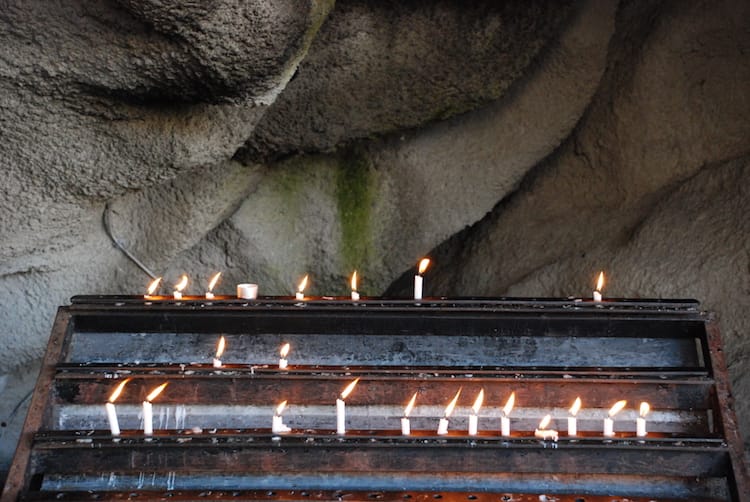What’s the best way to tell area residents about plans for a new asylum shelter nearby?
The government should tell communities directly about plans for new asylum shelters, some activists and politicians say.
Archbishop of Dublin John Charles McQuaid tried to stamp out what he saw as the indulgences associated with Inchicore’s own Lourdes grotto. But that didn’t stop the crowds.

People used to queue there to light candles at the grotto after Mass.
But at 11:55 a.m. on Sunday morning, Mass-goers exited Mary Immaculate Church in Inchicore, and hurried off out the front gate into the cold.
The cavernous grotto was unattended, its moss flecked with fresh dew. Only the Dijkinks remained.
Arm in arm with her husband Jan, Maura Dijkink lit a candle inside the concrete shrine. Back in the 1960s, when the faithful thronged this grotto, she was Maura Goggin, a youngster who grew up nearby – but she later moved to Amsterdam in the Netherlands.
“You’d be queuing to kiss the stone,” she said. “Most of them would come and they’d stand there.”
Dijkink points to the side door by the church’s sacristy, her hand sweeping back towards the looming concrete grotto that blocks out the sun.
The Oblates grotto, as it’s commonly known, is an anomaly. It towers 15 metres high and 40 metres wide, making it the largest of its kind in Dublin.
An imitation of the Massabielle grotto in Lourdes, France where the Virgin Mary supposedly appeared to Saint Bernadette in 1858, the structure sits at the back of Mary Immaculate Church off Tyrconnell Road in Dublin 8.
In 1924, Fr Michael Sweeney decided his parish needed a proper grotto, one to match the famous Massabielle known to Dubliners, many of whom could not make the trip in person in the 1920s.
Br Patrick McIntyre was then charged with its completion.

“It wasn’t professionally built or anything,” says Reverend Brian de Búrca, of Mary Immaculate. “He was a novice.”
McIntyre travelled back and forth to France, taking measurements of the Lourdes grotto. Local labourers banded together and, under McIntyre’s supervision, worked on the project between 1926 and 1930.
According to architectural historian Natalie de Róiste in the book More Than Concrete Blocks: Dublin City’s Twentieth-Century Buildings and Their Stories, the opening of the grotto was “advertised in the national newspapers for months in advance, with the assurance that the grounds could hold 100,000 people”.
The Oblates grotto represents an example, de Róiste says, “of the intersection of Dubliners’ religious traditions and transnational Modernist technologies of concrete”. Eighteen-thousand donors contributed £9,000 towards its construction.
“McIntyre was sort of our builder,” says de Búrca, who attended his funeral in 1963. “He was more than a handyman, though. He was fabulous.”
Built with reinforced concrete and steel wiring, and coated in cement, the Oblates grotto overlooks the church grounds, towards where McIntyre lies buried today.
On Sunday, a black-and-white cat appeared from behind the grotto, paused and turned down Rosary Way.
The Dijkinks are due back in Amsterdam the next morning, says Maura. These days it’s siblings that keep her coming back to the old parish, to the grotto that was once packed with parishioners.
“If the church was full, as it would be in those days, you’d go out behind the communion rails, out and say a prayer,” she says.
She can’t see the crib, perhaps it’s not up yet. But as a child she recalls the tradition, near the grotto, of burning down the Christmas crib.
Half-a-dozen wooden benches sit at the front of the grotto. Inside, three votive candle stands wait for the faithful. Twenty-one candles flicker on the stand to the right.

Outside, overlooking a blue-and-white pulpit, a statue of the Virgin Mary surveys the churchyard from a fissure.
Bulbous and undulating in form, the grotto looks today like a set piece yanked from a theme park, a concrete facsimile of excess.
For many years it functioned as an important place of prayer, though. “It was used all year ’round,” says Maura, a slight Dutch accent evident. “But especially in February.”
On 11 February, feast day of Our Lady of Lourdes, the grounds teemed with people. “They’d a torchlight procession,” says Maura. “People were very proud of it.”
But not everyone approved.
Perma-stern John Charles McQuaid was quick to stamp out what he saw as the indulgences associated with Inchicore’s own Lourdes recreation when he became archbishop of Dublin in 1940.
De Róiste recounts in More Than Concrete Blocks how McQuaid insisted that local water no longer be mixed with Lourdes water at the grotto and that the structure no longer be referred to as the Irish Lourdes.
McQuaid disapproved also of “torch-lit processions, praying with outstretched hands and all-night novenas, especially those with women in attendance”, she writes.
That didn’t stop the crowds flocking for torch-lit processions, though. “They’d gather in the schoolyard, they’d go ’round the grounds, walking up and down and up and down,” says Dijkink. “So many people.”
Shrines and grottoes were built all across Dublin in the early to mid-19th century, De Róiste notes, but none “attempted the ambitious level of precise imitation of that at Inchicore”.
Get our latest headlines in one of them, and recommendations for things to do in Dublin in the other.